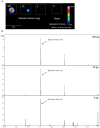Imaging Mass Spectrometry Reveals Acyl-Chain- and Region-Specific Sphingolipid Metabolism in the Kidneys of Sphingomyelin Synthase 2-Deficient Mice
- PMID: 27010944
- PMCID: PMC4806983
- DOI: 10.1371/journal.pone.0152191
Imaging Mass Spectrometry Reveals Acyl-Chain- and Region-Specific Sphingolipid Metabolism in the Kidneys of Sphingomyelin Synthase 2-Deficient Mice
Abstract
Obesity was reported to cause kidney injury by excessive accumulation of sphingolipids such as sphingomyelin and ceramide. Sphingomyelin synthase 2 (SMS2) is an important enzyme for hepatic sphingolipid homeostasis and its dysfunction is considered to result in fatty liver disease. The expression of SMS2 is also high in the kidneys. However, the contribution of SMS2 on renal sphingolipid metabolism remains unclear. Imaging mass spectrometry is a powerful tool to visualize the distribution and provide quantitative data on lipids in tissue sections. Thus, in this study, we analyzed the effects of SMS2 deficiency on the distribution and concentration of sphingomyelins in the liver and kidneys of mice fed with a normal-diet or a high-fat-diet using imaging mass spectrometry and liquid chromatography/electrospray ionization-tandem mass spectrometry. Our study revealed that high-fat-diet increased C18-C22 sphingomyelins, but decreased C24-sphingomyelins, in the liver and kidneys of wild-type mice. By contrast, SMS2 deficiency decreased C18-C24 sphingomyelins in the liver. Although a similar trend was observed in the whole-kidneys, the effects were minor. Interestingly, imaging mass spectrometry revealed that sphingomyelin localization was specific to each acyl-chain length in the kidneys. Further, SMS2 deficiency mainly decreased C22-sphingomyelin in the renal medulla and C24-sphingomyelins in the renal cortex. Thus, imaging mass spectrometry can provide visual assessment of the contribution of SMS2 on acyl-chain- and region-specific sphingomyelin metabolism in the kidneys.
Conflict of interest statement
Figures




References
-
- Stoeckli M, Chaurand P, Hallahan DE. Caprioli RM. Imaging mass spectrometry: a new technology for the analysis of protein expression in mammalian tissues. Nat Med. 2001;7: 493–496. - PubMed
Publication types
MeSH terms
Substances
LinkOut - more resources
Full Text Sources
Other Literature Sources
Medical
Molecular Biology Databases

